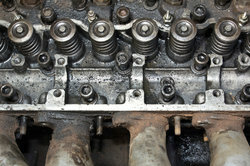The difference between 2-stroke and 4-stroke engines
Many mopeds and mopeds are equipped with a 2-stroke engine. Cars, on the other hand, are usually powered by a 4-stroke engine. There is a big difference between these two types of drive. But this is easy to explain.

Perhaps you have also wondered what the difference between a 2-stroke and a 4-strokeengine consists. Each of these two types of drive has advantages and disadvantages. The technology is easy to understand and easy to explain.
How a 4-stroke engine works
In a 4-stroke engine, the pistons move up and down in the cylinders. So there is no difference to a 2-stroke engine. There are inlet and outlet valves in the cylinder head. The valves are opened by means of camshafts and rocker arms. They are closed by strong compression springs.
- In the first stroke, the so-called intake stroke, the piston moves downwards in the cylinder. The inlet valve is open during this process. The fuel-air mixture is sucked in by the negative pressure in the combustion chamber of the cylinder.
- When the piston has reached its lowest position, the inlet valve is closed. The piston moves up and compresses the mixture. This stroke is called the compression stroke.
- Shortly before the piston has reached its highest position, a spark is created on the electrodes of the spark plug, which ignites the mixture. The combustion pressure pushes the piston down again. Since the actual work of the engine occurs during this cycle, this cycle is called the work cycle.
- In the last stroke the piston moves up again. The exhaust valve opens and the burned exhaust gases are passed through the exhaust manifold and the Exhaust pressed into the open. This cycle is called the exhaust cycle.
Due to their low power, 3-stroke engines are no longer ...
There is a difference to the 2-stroke engine
- A 2-stroke engine has no valves, but slots in the cylinder. That is the big difference to a 4-stroke engine.
- The intake and work cycle have been merged. The same applies to the compression and exhaust strokes.
- When the fuel-air mixture ignites, the piston in the cylinder is pushed down. A new mixture is sucked in at the same time.
- When the piston moves upwards, the mixture is compressed and the exhaust gases are blown out at the same time.
Since a 2-stroke engine has neither valves nor valve control, it is very compact and light. The difference to a 4-stroke engine is that the fuel is not burned as efficiently. This also has an impact on fuel consumption.
How helpful do you find this article?

